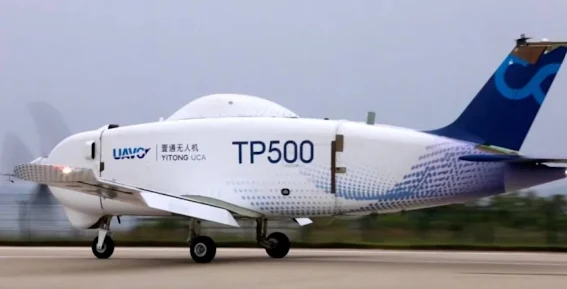 |
| The TP500 Drone, China's First Cargo Drone |
Beijing - China successfully flew its first cargo drone, the TP500 on June 18, 2022. As is well known, the TP500 is the country's first unmanned freight drone. The ship is manufactured by the First Aircraft Institute of the Aviation Industry Corporation of China (AVIC).
Quoted from the Eurasian Times, the drone can fly a standard load of 500 kilograms up to 500 kilometers, according to the claim by AVIC. The drone is also referred to as a general purpose unmanned transport platform with a large load and a maximum range of 1,800 kilometers.
This UAV is also reportedly equipped with a special tail that can be folded for easy access to the cargo compartment to speed up the loading process. The engine is reportedly front-mounted with a three-bladed propeller featuring a large center spinner.
The tricycle arrangement also regulates ground running. The TP500 is primarily designed and manufactured using composite materials and is assembled and linked by a sophisticated integrated process.
In addition to the cargo handling role, AVIC envisions a broad range of missions for the TP500, including Search & Rescue (SAR), air communications relay, and remote sensing mapping. According to the United Nations Conference on Trade and Development (UNCTAD), world trade in goods has increased dramatically over the past decade.
This is known to have increased from around $10 trillion in 2005 to $18.8 trillion in 2019. However, it fell to around US$17 trillion in 2020 due to the COVID-19 economic crisis. Therefore, aviation professionals suggest that all modes of transportation be automated in the coming decade.
This also means it will involve the integration of UCA into the supply chain. UCAs can be cheaper and more efficient than manned cargo planes because fewer personnel are required, as a single controller on the ground can operate multiple UCAs on a long flight.
In addition, it costs less to build a UCA than a manned aircraft for many reasons. Therefore, various cargo drones capable of carrying hundreds of thousands of kilograms of payload are being tested in flight and are expected to be operational in the next decade.
Quoted from japcc.org, this drone can offer important advantages for cargo transportation. Since there are no crew on board, it is likely that the drone cargo ship could take days to reach its destination. This is because it is flown at speeds optimized for efficient and environmentally friendly turboprop engines.
Not only that, UCA also only needs to return to its base for maintenance. Furthermore, UCA may not require pressurized cabs, only conditioned containers for certain types of cargo. This saves 10 – 20 % of empty weight and eliminates the need for a circular cab.
It also makes a new body structure feasible which can reduce drag by 15 – 20 %. Thus, it will be more fuel efficient.
Finally, empty return flights and load rejection due to scheduling problems may be avoided. This is also predicted as one of the rapid technological advances. With no crew on board, but being able to reach the destination certainly brings a lot of advantages.
